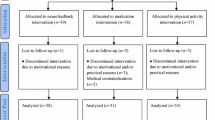Abstract
A study with three component parts was performed to assess the effectiveness of neurofeedback treatment for Attention Deficit/Hyperactivity Disorder (ADHD). The subject pool consisted of 23 children and adolescents ranging in age from 8 to 19 years with a mean of 11.4 years who participated in a 2-to 3-month summer program of intensive neurofeedback training. Feedback was contingent on the production of 16–20 hertz (beta) activity in the absence of 4–8 hertz (theta) activity. Posttraining changes in EEG activity, T.O.V.A. performance, (ADDES) behavior ratings, and WISC-R performance were assessed. Part I indicated that subjects who successfully decreased theta activity showed significant improvement in T.O.V.A. performance; Part II revealed significant improvement in parent ratings following neurofeedback training; and Part III indicated significant increases in WISC-R scores following neurofeedback training. This study is significant in that it examines the effects of neurofeedback training on both objective and subjective measures under relatively controlled conditions. Our findings corroborate and extend previous research, indicating that neurofeedback training can be an appropriate and efficacious treatment for children with ADHD.
Similar content being viewed by others
References
Barkley, R. A. (1990).Attention Deficit Hyperactivity Disorder: A handbook for diagnosis and treatment. New York: Guilford Press.
Brown, R. T., Borden, K. A., Wynne, M. E., & Schleser, R. (1986). Methylphenidate and cognitive therapy with ADD children: A methodological reconsideration.Journal of Abnormal Child Psychology, 14 481–497.
Etevenon, P. (1986). Application and perspectives of EEG cartography. In F. H. Duffy (Ed.),Topographic mapping of brain electrical activity (pp. 113–141). Boston: Butterworth.
Fein, G., Galin, D., Johnstone, J., Yingling, C., Marcus, M., & Kiersch, M. (1983). EEG power spectra in normal and dyslexic children.Electroencephalography and Clinical Neurophysiology, 55 399–405.
Greenberg, L. (1987). An objective measure of methylphenidate response: Clinical use of the MCA.Psychopharmacology Bulletin, 23 279–282.
Lubar, J. F. (1991). Discourse on the development of EEG diagnostics and biofeedback treatment for attention-deficit/hyperactivity disorders.Biofeedback and Self-Regulation, 15 201–225.
Lubar, J. F., & Bahler, W. W. (1976). Behavioral management of epileptic seizures following EEG biofeedback training of the sensorimotor rhythm.Biofeedback and Self-Regulation, 7 77–104.
Lubar, J. F., & Deering, W. M. (1981).Behavioral approaches to neurology. New York: Academic Press.
Lubar, J. F., & Lubar, J. (1984). Electroencephalographic biofeedback of SMR and beta for treatment of attention deficit disorders in a clinical setting.Biofeedback and Self-Regulation, 9 1–23.
Lubar, J. F., & Shouse, M. N. (1977). Use of biofeedback in the treatment of seizure disorders and hyperactivity. In B. B. Lahey & A. E. Kazdin (Eds.),Advances in clinical child psychology (pp. 203–265). New York: Plenum Press.
Mann, C., Lubar, J., Zimmerman, A., Miller, C., & Muenchen, R. (1991). Quantitative analysis of EEG in boys with attention-deficit-hyperactivity disorder: Controlled study with clinical implications.Pediatric Neurology, 8 30–36.
McCarney, S. (1989). Attention Deficit Disorders Evaluation Scale Home Version. Missouri: Hawthorne Educational Services Inc.
Sterman, M. G., Macdonald, L. R., & Stone, R. K. (1974). Biofeedback training of the sensorimotor electroencephalographic rhythm in man: Effects on epilepsy.Epilepsia, 15 395–416.
Tansey, M. A. (1990). Righting the rhythms of reason, EEG biofeedback training as a therapeutic modality in a clinical office setting.Medical Psychotherapy, 3 57–68.
Tansey, M. A. (1991). Wechsler's (WISC-R) changes following treatment of learning disabilities via EEG biofeedback training in a private setting.Australian Journal of Psychology, 43 147–153.
Tansey, M. A., & Bruner, R. L. (1983). EMG and EEG biofeedback training in the treatment of a 10-year-old hyperactive boy with a developmental reading disorder.Biofeedback and Self-Regulation, 8 25–37.
Wolraich, M. L., Lindgren, S., Stromquist, A., Milich, R., Davis, C., & Watson, D. (1990). Stimulant medication use by primary care physicians in the treatment of attention-deficit hyperactivity disorder.Pediatrics, 86 95–101.
Zametkin, A. J., Nordahl, T. E., Gross, M., King, A., Semple, W., Rumsey, J., Hamburger, S., & Cohen, R. (1990). Cerebral glucose metabolism in adults with hyperactivity of childhood onset.New England Journal of Medicine, 323 1361–1366.
Author information
Authors and Affiliations
Additional information
The first author (Joel F. Lubar) has provided consultative services for both Lexicor and Stoelting-Autogenics Corporations in order to help them develop appropriate protocols for neurofeedback. He is not an owner, stockholder, or employee for either organization.
Rights and permissions
About this article
Cite this article
Lubar, J.F., Swartwood, M.O., Swartwood, J.N. et al. Evaluation of the effectiveness of EEG neurofeedback training for ADHD in a clinical setting as measured by changes in T.O.V.A. scores, behavioral ratings, and WISC-R performance. Biofeedback and Self-Regulation 20, 83–99 (1995). https://doi.org/10.1007/BF01712768
Issue Date:
DOI: https://doi.org/10.1007/BF01712768




